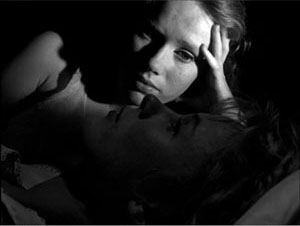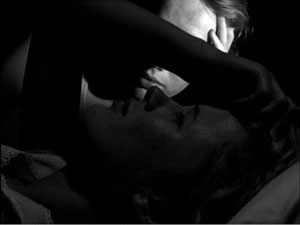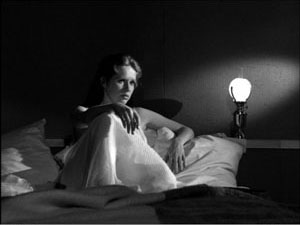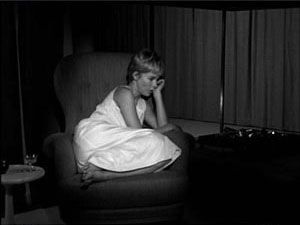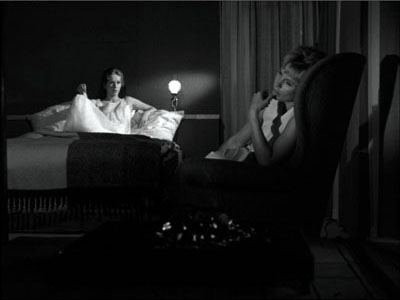“Power and
freedom.” Coupled together, these two words are repeated three times in Vertigo. First, at the twelfth
minute by Gavin Elster (“freedom” underlined by a move to close-up) who,
looking at a picture of Old San Francisco, expresses his
nostalgia to Scottie (“San Francisco has changed. The things that spelled San Francisco to me are disappearing fast”), a nostalgia for a
time when men—some men at least—had “power and freedom.”
Second, at the thirty-fifth minute, in the
bookstore, where ‘Pop’ Liebel explains how Carlotta Valdes's rich lover threw her out yet kept her child: “Men could do that in those
days. They had the power and the freedom...” And finally
at the hundred and twenty-fifth minute—and fifty-first second to be
precise—but in reverse order (which is logical,
given we are now in the second part, on the other side of the mirror) by Scottie himself when, realizing the workings of the trap laid
by the now free and powerful Elster, he says, a few seconds
before Judy's fall—which, for him, will be
Madeleine's second death—“with all his wife's money and all that freedom and power...”. Just try telling me these are coincidences.
Such precise
signs must have a meaning. Could it be psychological, an explanation of the criminal’s motives? If so, the effort seems a little
wasted on what is, after all, a secondary character. This
strategic triad gave me the first inkling of a possible
reading of Vertigo. The vertigo the film deals with isn't to
do with space
and falling; it is a clear, understandable and spectacular metaphor for yet another kind of vertigo, much more
difficult to represent—the vertigo of time. Elster's
‘perfect’ crime almost achieves the impossible: reinventing a time when men and
women and San Francisco were different to what they are now.
And its perfection, as with all perfection in Hitchcock, exists in duality. Scottie will absorb the folly of time with which
Elster infuses him through Madeleine/Judy. But where Elster
reduces the fantasy to mediocre
manifestations (wealth, power, etc), Scottie transmutes it into its most utopian form: he overcomes the most irreparable damage caused by time and resurrects a love that is dead. The entire second part of the film, on
the other side
of the mirror, is nothing but a mad, maniacal attempt to deny time, to recreate
through trivial yet necessary signs (like the signs of a liturgy: clothes,
make-up, hair) the woman whose loss he has never been able to accept. His own feelings of responsibility and guilt for
this loss are mere Christian Band-Aids dressing a metaphysical wound
of much greater depth. Were one to quote the
Scriptures, Corinthians I (an epistle one of Bergman’s characters uses to define love) would apply: “Death, where is your
victory?”
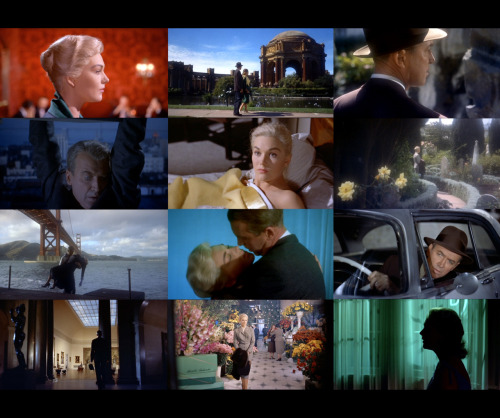
So Elster
infuses Scottie with the madness of time. It's interesting to see how this is done. As ever with Alfred, stratagems merely serve to hold
up a mirror (and there are many mirrors in this story)
to the hero and bring out his repressed
desires. In Strangers on a Train, Bruno offers Guy the crime he doesn't dare desire.
In Vertigo, Scottie, although overtly reluctant, is always willing, always the one taking the first step. Once in Gavin's office
and again in front of his own house, (the morning after the
fake drowning), the manipulators pretend to give up: Gavin sits down and
apologizes for having asked the impossible; Madeleine gets back in the car and gets ready to leave. Everything could stop there. But, on both occasions, Scottie takes the
initiative and restarts the machine. Gavin hardly has to
persuade Scottie to undertake his search: he simply
suggests that he see Madeleine, knowing full well that a glimpse of her will be enough to set the supreme manipulator, Destiny,
in
motion. After a shot of Madeleine, glimpsed at
Ernie's, there follows a shot of Scottie beginning his
stake-out of the Elster house. Acceptance (bewitchment) needs no scene of its own; it is contained in the fade to black between
the two scenes. This is the first of three ellipses of
essential moments, all avoided, which another
director would have felt obliged to show. The second ellipse is in the first scene of physical love between Judy and Scottie, which
clearly takes place in the hotel room after the last
transformation (the hair-do corrected in the bathroom). How is
it possible, after such a fabulous, hallucinatory moment, to sustain such intensity?
In this case,
the censorship of the time saved Hitchcock from a doubly impossible situation. Such a scene can only exist in the imagination (or
in life). But when a film has referred to fantasy only in the
highly-coded context of dreams and two lovers
embrace in the realist set of the hotel room; when one of them, Scottie, thanks to the most magical camera movement in the
history of cinema, discovers another set around him, that
of the stable at the Dolores Mission where he last
kissed a wife whose double he has now created; isn't that scene the metaphor for the love scene Hitchcock
cannot show? And if love is truly the
only victor over time, isn't this scene per se the love scene? The third ellipse, which has long been the joy of connoisseurs, I'll mention
for the sheer pleasure of it. It occurs much earlier, in
the first part. We have just seen Scottie pull
Madeleine unconscious out of San Francisco bay (at Fort Point). Fade to black. Scottie is at home, lighting a log fire. As he goes to
sit down—the camera follows—he looks straight ahead. The camera follows his
look and ends on Madeleine, seen through the open bedroom
door, asleep in bed with a sheet up to her neck.
But as the camera travels towards her, it also registers her clothes and underclothes hanging on a drier in the kitchen. The
telephone rings and wakes her up. Scottie, who's come into
the room, leaves, shutting the door. Madeleine reappears dressed in the red dressing-gown he happened to have draped across the bed. Neither of them alludes to the intervening
period, apart from the double entendre in Scottie's
line the next day: “I enjoyed, er... talking to you...”
Three scenes, therefore, where imagination wins over representation; three
moments, three keys which become locks, but which no present-day director would think of leaving out. On the contrary, he'd
make them heavily explicit and, of course, banal. As a
result of saying it can show anything, cinema has
abandoned its power over the imagination. And, like cinema, this century is perhaps starting to pay a high price for this
betrayal of the imagination—or, more precisely, those who still
have an imagination, albeit a poor one,
are being made to pay that price.
Double
entendre? All the gestures, looks, phrases in Vertigo have
a double meaning. Everybody knows that it is probably the
only film where a “double” vision is not only
advisable but indispensable for rereading the first part of the film in the light of the second. Cabrera Infante called it “the first
great surrealist film,” and if there is a theme present in the surrealist
imagination (and for that matter, in the literary one), then surely it is that of the Double, the Doppelganger (who from Doctor
Jekyll to Kagemusha, from the Prisoner of Zenda to Persona, has trod a royal path
through the history of the medium). In Vertigo, the theme is even
reflected in the doubling-up of details: Madeleine's look
towards the tower (the first scene of San Juan Bautista, looking right, while
Scottie kisses her) and the line “Too late” which accompanies it have a precise meaning for the naive spectator, unaware of the
stratagem, but another meaning, just as precise, for a watchful
spectator seeing it a second time. The look and
the line are repeated at the very end, in a shot exactly sym- metrical with the first, by Scottie, looking left, “Too late,” just
before Judy falls. For as there is an Other of the Other, there is
also a Double of the Double. The right profile of the
first revelation, when Madeleine momentarily stands still behind Scottie at Ernie's, the moment which decides everything, is
repeated at the beginning of the second part, so precisely that
it's Scottie who, the second time, is “in front”
of Judy. Thus begins a play of mirrors which can only end in their destruction. We, the audience,
discover the stratagem via the letter Judy doesn't send. Scottie
discovers it at the end via the necklace. (Note that this moment also has its double: Scottie has just seen the necklace head-on
and
hasn't reacted. He only reacts when he sees it in
the mirror.) In between, Scottie's attraction
for Judy, who at first was merely a fourth case of mistaken identity (the constant of a love touched by death; see Proust) Scottie
encountered in his search through the places of their past, this attraction has
crystallized with her profile in front of the window (“Do I remind you of her?”)
in that green neon light, for which Hitchcock, it seems,
specially chose the Empire Hotel: her left
profile. This is the moment when Scottie crosses to the other side of the mirror and his folly is born ...
...If one
believes, that is, the apparent intentions of the authors (authors in the plural because the writer, Samuel Taylor, was largely Alfred's
accomplice). The ingenious stratagem, the way of making us
understand we've been hood-winked, the stroke of genius of revealing the truth
to us well before the hero, the whole thing
bathed in the light of an amour fou, “fixed” by what Cabrera (who should know)
called the “decadent habaneras” of Bernard Herrman—all that isn't bad. But
what if they were lying to
us as well? Resnais liked to say that nothing forces
us to believe the heroine of Hiroshima. She could be making up everything she says. The flashbacks aren't the
affirmations of the writer, but stories told by a
character. All we know about Scottie at the beginning of the second part is that he is in a state of total catatonia, that he is
“somewhere else,” that it “could last a long time” (according
to the doctor), that he loved a dead woman “and still
does” (according to Midge). Is it too absurd to imagine that this agonizing, though reasonable, and obstinate soul
(“hard-hitting” says Gavin), imagined this
totally extravagant scenario, full of unbelievable coincidences and
entanglements, yet logical enough to drive one to the one salvatory conclusion: this woman is not dead, I can find her again?
There are many
arguments in favour of a dream reading of the second part of Vertigo. The disappearance of
Barbara Bel Geddes (Midge, his friend and confidante, secretly
in love with him) is one of them. I know very well that she married a rich Texan oilman in the meantime, and is preparing a dreadful reappearance as a widow in the Ewing clan; but still, her disappearance
from Vertigo is probably
unparalleled in the serial economy of Hollywood scripts. A character important for half the film disappears without trace—there
isn't even an allusion to her in the subsequent dialogue—until
the end of the second part. In the dream
reading of the film, this absence would only be explained by her last line to Scottie in the hospital: “You don't even know I'm
here...”
In this case,
the entire second part would be nothing but a fantasy, revealing at last the double of the double. We were tricked into believing that
the first part was the truth, then told it was a lie born of
a perverse mind, that the second part contained the truth. But what if the
first part really were the truth and the second the
product of a sick mind? In that case, what one may find overcharged and outrageously expressionistic in the nightmare images
preceding the hospital room would be nothing but a trick, yet another red
herring, camouflaging the fantasy that will occupy us for
another hour in order to lead us even further away
from the appearance of realism. The only exception to this is the moment I've already mentioned, the change of set during the
kiss. In this light, the scene acquires a new meaning: it's
a fleeting confession, a revealing detail, the blink of a madman's eyelids as
his eyes glaze over, the kind of gaze which sometimes
gives a madman away.
There used to
be a special effect in old movies where a character would detach himself from his sleeping or dead body, and his transparent form
would float up to the sky or into the land of dreams. In
the mirror play of Vertigo there is a similar
moment, if in a more subtle form: in the clothes store when Judy, realizing that Scottie is transforming her piece by piece into
Madeleine (in other words, into the reality he isn't deemed
to know, making her repeat what she did for
Elster), makes to go, and bumps into a mirror. Scottie joins her in front of the
mirror and, while he's dictating to an amazed shop assistant the details of one of Madeleine's dresses, a fabulous shot shows us “all
four of them” together: him and his double, her and her
double. At that moment, Scottie has truly
escaped from his hospital chair: there are two Scotties as well as two Judys. We can therefore add schizophrenia to the illnesses whose
symptoms others have already judiciously identified in Scottie's behaviour. Personally, though, I'd leave out necrophilia, so often mentioned, which
seems to me more indicative of a critic's neurosis than
the character's: Scottie continues to love a truly living Madeleine. In his
madness, he looks for proof in her life.
It's all very
well reasoning like this, but one must also return to the appearance of the
facts, obstinate as they are. There is a crushing argument in favour of a phantasmagoric reading of the second part. When, after the
transformation and the hallucination, Madeleine/Judy, with the blitheness of a
satisfied body, gets ready for dinner and Scottie asks her
what restaurant she'd like to go to, she
immediately suggests Ernie's. It's the place where they first met (but Scottie isn't meant to know this yet—Judy's careless “It's our place” is
the first give-away before the necklace). So they go there without making a reservation. Just try doing this
in San Francisco and you'll understand we're in a dream.
As Gavin says,
San Francisco has changed. During a screening at Berkeley in the early eighties, when everyone had forgotten the movie (the old fox
had
kept the rights in order to sell them at a premium
to TV, hence the cuts for commercials and the
changed ending) and the word was that it was just another minor thriller, I
remember the audience gasping with amazement on seeing the panoramic view of the city which opens the second part. It's another
city, without skyscrapers (apart from Coppola's Sentinel
Building), a picture as dated as the engraving Scottie looks at when Elster
first pronounces those two fateful words. And it
was only twenty years ago... San Francisco, of course, is nothing but another character in the film. Samuel Taylor wrote to me
agreeing that Hitchcock liked the town but only knew “what
he saw from hotels or restaurants or out of
the limo window.” He was “what you might call a sedentary person.” But he still
decided to use the Dolores Mission and, strangely, to make the house on Lombard Street Scottie's home “because of the red door.” Taylor was in love
with his city (Alex Coppel, the first writer, was “a transplanted Englishman”)
and put all his love into the script; and perhaps even more than that, if I am to believe a rather cryptic phrase at the end of
his letter: “I rewrote the script at the same time that I explored San
Francisco and recaptured my past...” Words which could apply as
much to the characters as to the authors and
which afford us another interpretation, like an added flat to a key, of the direction given by Elster to Scottie at the
start of the film, when he's describing
Madeleine's wanderings; the pillars Scottie gazes at for so long on the other side of Lloyd Lake—the Portals of the Past. This personal note would explain many
things: the amour fou, the dream signs, all
the things that make Vertigo a film which is both typically and untypically
Hitchcockian in relation to the rest of his work, the work of a
perfect cynic. Cynical to the point of adding for
television—an anxiously moral medium, as we all know—a new ending to the film:
Scottie reunited with Midge and the radio reporting Elster's arrest. Crime doesn't pay.
Ten years
later, time has continued to work its effect. What used to mean San Francisco for me is disappearing fast. The spiral of time, like Saul
Bass's spiral in the credit sequence, the spiral of
Madeleine's hair and Carlotta's in the portrait, cannot
stop swallowing up the present and enlarging the contours of the past. The Empire Hotel has become the York and lost its green
neon lights; the McKittrick Hotel, the Victorian house
where Madeleine disappears like a ghost (another
inexplicable detail if we ignore the dream-reading: what of the hotel's mysterious janitress? “A paid accomplice' was Hitchcock's
reply to Truffaut. Come on, Alfred!) has been replaced by
a school built of concrete. But Ernie's
restaurant is still there, as is Podesta Baldocchi's flower-shop with its tiled mosaics where one proudly remembers Kim Novak choosing a
bouquet. The cross-section of sequoia is still at the entrance to Muir Woods,
on
the other side of the bay. The Botanical Gardens
were less fortunate: they are now parked
underground. (Vertigo could almost
be shot in the same locations, unlike its remake in
Paris.) The Veterans' Museum is still there, as is the cemetery at the Dolores
Mission and San Juan Bautista, south of another mission, where Hitchcock added (by an optical effect) a high tower, the real one
being so low you'd hardly sprain an ankle falling off it,
complete with stable, carriages and stuffed horse used in the film just as they
are in life. And of course, there's Fort Point,
under the Golden Gate Bridge, which he wanted to cover with birds at the end of The Birds. The Vertigo tour is now
obligatory for lovers of San Francisco. Even the Pope, pretending
otherwise, visited two locations: the Golden Gate Bridge and (under the pretext
of kissing an AIDS patient) the Dolores Mission. Whether one accepts
the dream reading or not, the power of this
once ignored film has become a commonplace, proving that the idea of resurrecting a lost love can touch any human heart, whatever
he or she may say. “You're my second chance!' cries
Scottie as he drags Judy up the stairs of the tower.
No one now wants to interpret these words in their superficial sense, meaning his vertigo has been conquered. It's about reliving a moment lost in the past, about bringing it back to life only to lose it
again. One does not resurrect the dead, one doesn't look
back at Eurydice. Scottie experiences the
greatest joy a man can imagine, a second life, in exchange for the greatest tragedy, a second death. What do video games, which tell us
more about our unconscious than the works of Lacan,
offer us? Neither money nor glory, but a new
game. The possibility of playing again. “A second chance.” A free replay. And another thing: Madeleine tells Scottie she managed to
find her way back to the house “by spotting the Coit Tower'—the
tower which dominates the surrounding hills and whose name makes visiting
French tourists laugh. I “Well, it's the first time I ever had to
thank the Coit Tower,” says Scottie, the blase
San Franciscan. Madeleine would never find her way back today. The bushes have grown on Lombard Street, hiding all landmarks.
The
house itself, number goo, has changed. The new
owners have got rid of (or the old owner kept) the
cast-iron balcony with its Chinese inscription “Twin Happiness.” The door is still red, but now blessed with a notice which,
in its way, is a tribute to Alfred: “Warning: Crime Watch.”
And, from the steps where Kim Novak and James
Stewart are first reunited, no one can see any more the tower “in the shape of a fire-hose,” offered as a posthumous gift to the
San
Francisco Fire Brigade by a millionairess called
Lilli Hitchcock Coit ...
Obviously,
this text is addressed to those who know Vertigo by heart. But do those who don't
deserve anything at all?
Originally published at Positif , n°400, june 1994, p.79.
I went to the beach on my own. It was a warm and nice day.There was another girl there. She had come from another island because our beach was sunnier and more secluded. We lay there completely naked and sunbathed... dozing off and on, putting sunscreen on. We had silly straw hats on. Mine had a blue ribbon. I lay there... looking out at the landscape, at the sea and the sun. It was kind of funny. Suddenly I saw two figures on the rocks above us. They hid and peeped out occasionally. "Two boys are looking at us," I said to the girl. Her name was Katarina. "Let them look," she said, and turned over on her back. I had a funny feeling. I wanted to jump up and put my suit on, but I just lay there on my stomach with my bottom in the air, unembarrassed, totally calm. And Katarina was next to me with her breasts and big thighs. She was just giggling. I noticed that the boys were coming closer. They just stood there looking at us. I noticed they were very young. The boldest one approached us... and squatted down next to Katarina. He pretended to be busy picking his toes. I felt very strange. Suddenly Katarina said to him, "Hey, you, why don't you come over here?" Then she took his hand and helped him take off his jeans and shirt. Suddenly he was on top of her. She guided him in and held his butt. The other boy just sat and watched. I heard Katarina whisper in the boy's ear and laugh. His face was right next to mine. It was red and swollen. Suddenly I turned and said, "Aren't you coming to me, too?" And Katarina said, "Go to her now." He pulled out of her and... then fell on top of me, completely hard. He grabbed my breast. It hurt so much! I was overwhelmed and came almost immediately. Can you believe it? I wanted to tell him to be careful not to make me pregnant... when he came. I felt something I'd never felt in my life... how his sperm was shooting inside me. He held my shoulders and bent backwards. I came over and over. Katarina lay there watching and held him from behind. After he came, she took him in her arms and used his hand to make herself come. When she came, she screamed like a banshee. The three of us started laughing. We called to the other boy, who was sitting on the slope. His name was Peter. He seemed confused and was shivering there in the sunshine. Katarina unbuttoned his pants and started to play with him. And when he came, she took him in her mouth. He bent down and kissed her back. She turned around, took his head in both hands, and gave him her breast. The other boy got so excited that he and I started all over again. It was just as nice as before. Then we had a swim and went our separate ways.
